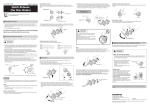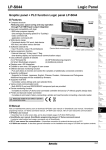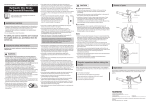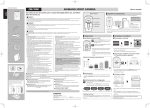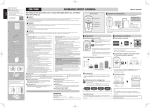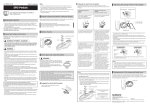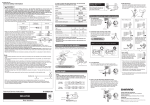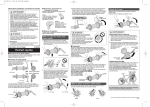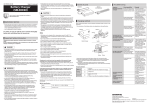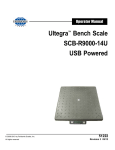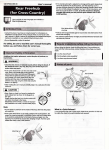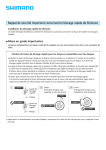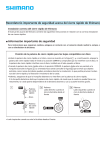Transcript
User's manual
UM-3000H-003-00
Quick Release
What is a Quick Release?
It is a mechanism that uses a single quick release lever operation on the hub to enable
the wheel to be easily installed and removed.
Quick Release function
CLOSE position
When the quick release lever is brought
to the closed position, the lever nut
moves inward. The force of this clamps
the wheel to the frame and holds the
wheel securely in place.
User's manuals in other languages are available at :
http://si.shimano.com
3. Grip the fork with your fingers and use the palm of your hand to close the quick
release lever with as much strength as possible. When closed, the quick release lever
must be in the "CLOSE" position shown below in the diagram on the right. The side of
the lever with the inscription "CLOSE" must be facing away from the bicycle, and the
lever should be parallel to the fork as shown below in the diagram on the left.
Tightening torque:
5.0 -7.5 N·m {44 -66 in. lbs.}
CLOSE position
Fork
Quick
release
lever
• Contact the place of purchase or a bicycle dealer for information on installation and
adjustment of the products which are not found in the user's manual. A dealer's
manual for professional and experienced bicycle mechanics is available on our website
(http://si.shimano.com).
OPEN position
Lever nut
Quick release lever
Regular inspections before riding the bicycle
Open position
• Do not disassemble or alter this product.
The clamping strength is adjusted by turning the adjusting nut. When the nut is turned
in a clockwise direction, the clamping strength increases, and when the nut is turned in a
counter-clockwise direction, the clamping strength decreases.
Important Safety Information
Stronger
Guidelines that require replacement, contact the place of purchase or a bicycle dealer.
Before riding the bicycle, check the following items. If any problems are found with the
following items, contact the place of purchase or a bicycle dealer.
CAUTION
Never fasten a wheel to a frame by rotating the quick
release lever as shown in the diagram on the right.
Simply rotating the lever in a circular motion will not
fasten the wheel to the frame.
Detachment of the wheel as a result of improper hub
installation can result in serious bodily injury.
WARNING
THINGS TO CHECK BEFORE RIDING
1. Always check your quick release hubs before riding to make sure that the wheels
are correctly installed on the bicycle frame. This is especially important after you
park your bicycle in a public place.
WARNING
• This wheel is equipped with a quick release hub to facilitate installation and removal.
Failure to properly install this quick release hub (wheel) onto your bicycle may cause
the wheel to become detached from the bicycle while you are riding and result in
serious bodily injury.
• Use a front fork which is equipped with a wheel retention mechanism.
• BEFORE USE, CAREFULLY READ THE QUICK RELEASE SERVICE INSTRUCTIONS IN YOUR
OWNER'S MANUAL. IF YOU HAVE ANY QUESTIONS, ASK YOUR DEALER. IMPROPER
HUB INSTALLATION CAN RESULT IN SERIOUS BODILY INJURY.
Quick release lever position for rotor compatible hubs
• Install the quick release lever to the rotor as shown in Figure 1 , and then fully
push the quick release lever to the CLOSE position and check that it does not
interfere with the rotor. If the quick release lever interferes with the rotor, install it
on the opposite side to the rotor.
• When the quick release lever is in CLOSE position, the lever should be in parallel
position with the fork (refer to Figure 2a ) or face toward back of the bicycle (refer
to Figure 2b ) in order to prevent foreign objects such as tree branches from getting
stuck during the ride, which can cause the quick release to open and cause the
wheel to release unintentionally from the fork.
• Furthermore make sure that the front fork does not interfere with the quick release
lever.
If the front fork obstructs the quick release lever so that the wheel cannot be
secured properly, the wheel may fall off the bicycle during riding and serious injury
may occur as a result.
Adjusting nut
Weaker
Note
If the quick release lever can be easily pushed to the CLOSE position, this means the
clamping strength is insufficient. Return the quick release lever to the position
perpendicular to the bicycle frame and again turn the adjusting nut clockwise to increase
the clamping trength. Push the quick release lever back to the CLOSE position.
Suitable dimensions of the fork end
Be sure to use only fork widths with suitable dimensions.
2. Make sure that the quick release levers are pushed fully to the CLOSE position (the
side of the lever with the inscription "CLOSE" must be facing away from the
bicycle).
As shown in the diagram the lever must be lifted, not rotated.
CLOSE position
Front ...
cannot use fork thicknesses less than 4 mm.
(Dura-Ace, 600 Ultegra: not less than 5 mm.)
OPEN position
QUICK CHECK
Rear ...
cannot use fork thicknesses less than 5 mm.
(Dura-Ace, 600 Ultegra: not less than 6 mm.)
Adjusting nut
Operation
The front axle is explained as an example. The rear axle works in the same way.
If the clamping strength is adjusted too strong and the quick release lever cannot be
pushed to the CLOSE position, turn the adjusting nut in a counter-clockwise direction to
reduce the clamping strength. When doing this, do not fully release the adjuster nut.
Turn it 1/8 of a revolution, and then try to push the lever to CLOSE, to set the
maximum clamping strength with which you can push the quick release lever
to the CLOSE position.
Lift up the bicycle so that the wheel is off the ground, and give the top of the tire a
few sharp downward blows as shown in the diagram. The wheel should not be loose
or come off. This check does not guarantee that the quick release lever has received
adequate tightening torque.
If you are uncertain as to whether the quick release is tightened correctly, repeat the
installation procedure as explained in "How to fasten this quick release hub" of this
service instruction.
How to fasten this quick release hub
1
OK
Not OK
Quick
release
lever
Rotor
Quick
release
lever
1. Move the quick release lever to the OPEN position and set the wheel so it firmly
touches the interior of the fork end (See sketch below).
Turn 1/8 revolution at
a time
Rotor
OK
2a
Move the quick release lever from the CLOSE position to the OPEN position.
Loosen the adjusting nut, and then remove the wheel.
Adjusting nut
IMPORTANT NOTICE
For safety, be sure to read this user's manual thoroughly before use,
and follow them for correct use.
Removing the wheel
Lever :
Right side when looking at the
bicycle from the front
OK
2b
Lever :
Left side when looking at the bicycle
from the front
Positioning of the quick release lever
For safety, the quick release lever should be along the bicycle frame when in the CLOSE
position.
OPEN position
If the quick release will not adjust properly, please contact a professional dealer for
advice.
Not OK
OK
Not OK
Not OK
2. Open and close the quick release lever with your right hand while gradually
tightening the adjusting nut with your left hand in the clockwise direction. Continue
tightening the nut until you feel resistance with your hand at the point when the
lever is parallel to the hub (as indicated by the dotted position in the diagram on the
right).
Rear
Front
• After reading the user's manual carefully, keep it in a safe place for later reference.
NOTICE
• Be sure to operate the quick release lever by hand only. Never use any other tool such
as a hammer to tighten the quick release lever, as this could cause damage to the lever.
Note
• Products are not guaranteed against natural wear and deterioration from normal use
and aging.
• For maximum performance we highly recommend Shimano lubricants and maintenance
products.
Quick release lever
Adjusting nut
One Holland, Irvine, California 92618, U.S.A. Phone: +1-949-951-5003
Industrieweg 24, 8071 CT Nunspeet, The Netherlands Phone: +31-341-272222
3-77 Oimatsu-cho, Sakai-ku, Sakai-shi, Osaka 590-8577, Japan
Please note: specifications are subject to change for improvement without notice. (English)
© Aug. 2012 by Shimano Inc. HTR
